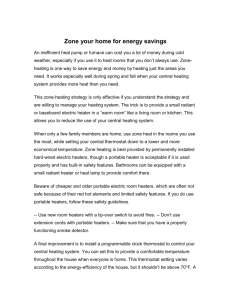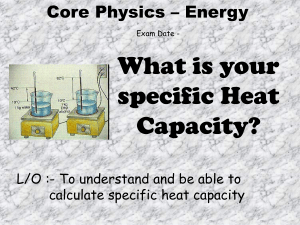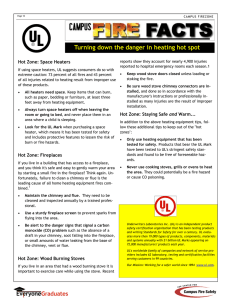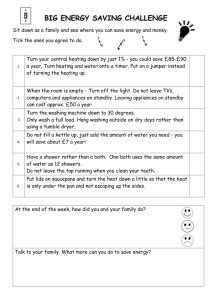Supplemental Heating
advertisement
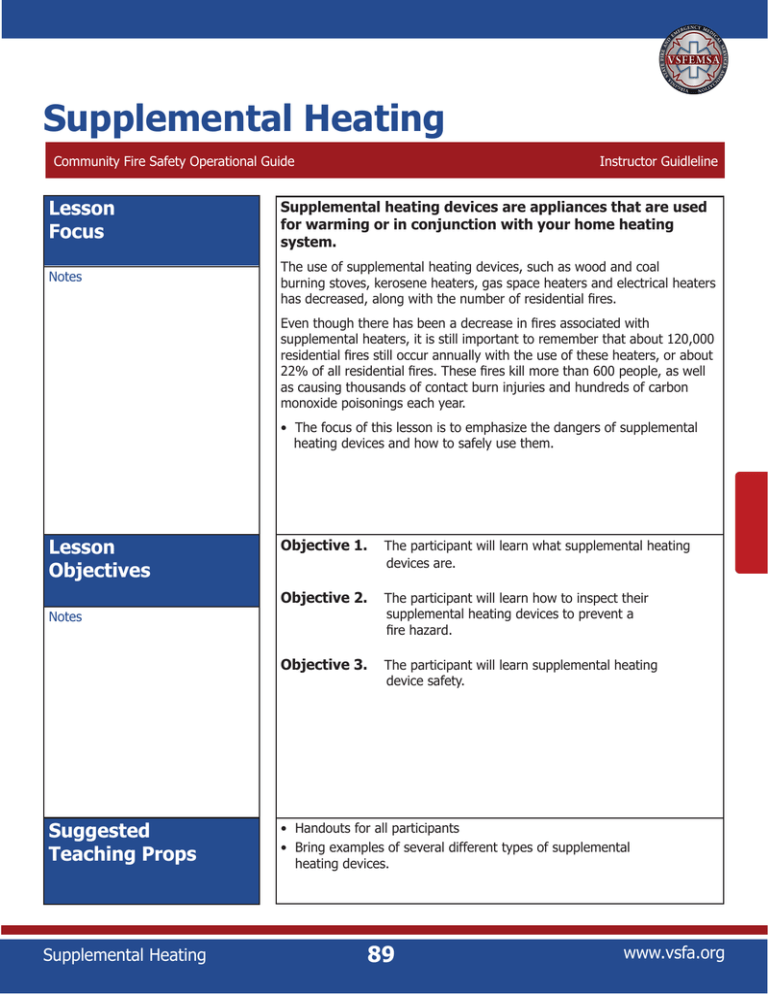
Supplemental Heating Community Fire Safety Operational Guide Instructor Guidleline Lesson Focus Supplemental heating devices are appliances that are used for warming or in conjunction with your home heating system. Notes The use of supplemental heating devices, such as wood and coal burning stoves, kerosene heaters, gas space heaters and electrical heaters has decreased, along with the number of residential fires. Even though there has been a decrease in fires associated with supplemental heaters, it is still important to remember that about 120,000 residential fires still occur annually with the use of these heaters, or about 22% of all residential fires. These fires kill more than 600 people, as well as causing thousands of contact burn injuries and hundreds of carbon monoxide poisonings each year. • The focus of this lesson is to emphasize the dangers of supplemental heating devices and how to safely use them. Lesson Objectives Objective 1. The participant will learn what supplemental heating devices are. Objective 2. The participant will learn how to inspect their supplemental heating devices to prevent a fire hazard. Objective 3. The participant will learn supplemental heating device safety. Notes Suggested Teaching Props Supplemental Heating • Handouts for all participants • Bring examples of several different types of supplemental heating devices. 89 www.vsfa.org Supplemental Heating Community Fire Safety Operational Guide Instructional Points Notes Instructor Guidleline Supplemental heating devices or appliances are those devices that are typically used in conjunction with your home’s main heating source. • Portable electric space heaters - These frequently used supplemental devices are responsible for thousands of fires and many deaths annually. • Kerosene heaters – Another heating device that is responsible for thousands of fires and deaths. • Wood Stoves – Wood and coal burning appliances and chimney assemblies are responsible for over 100,000 fires annually and hundreds of fire related deaths. • Gas Heaters – Likewise, many fire incidents involve gas heating appliances. Annually these appliances account for almost 20,000 fires and several hundred fire fatalities. Maintaining your supplemental heating device is just as important as maintaining your home’s heating and cooling system. Notes www.vsfa.org • Inspect your appliance before the heating season begins and look for frayed cords, wicks and pilot light function, and have your chimney cleaned and inspected by a reputable contractor. • Be familiar with emergency shut offs for these appliances and make sure they are working properly. • Keep appliance a minimum of 3 feet from combustibles and be sure there is adequate ventilation in the room. • Be sure to fuel your appliance with the appropriate type fuel. • Make sure you have a working smoke detector and carbon monoxide detector. • Never use a vented appliance without proper venting. • Make sure your burner is producing an adequate flame to prevent incomplete combustion causing carbon monoxide. • Follow all lighting instructions. • Never check for gas leaks with a lighter. Use a soap solution or commercial leak detector. 90 Supplemental Heating Supplemental Heating Community Fire Safety Operational Guide Instructor Guidleline Instructional Points Supplemental heating devices can be a good supplement to other residential heating sources. Follow these safety recommendations to help prevent fire hazards. Notes Wood Stove Safety Notes Kerosene Heater Safety • Do not use wood burning stoves and fireplaces unless they are properly installed and meet building codes. • Follow the label instructions on the stove which recommends an inspection twice yearly. Have chimneys inspected and cleaned by a professional chimney sweep. Creosote is an unavoidable product of wood burning stoves. Creosote builds up in chimney flues and can cause a chimney fire. • Use a code-specified or listed floor protector. It should extend 18 inches beyond the stove on all sides. This will reduce the possibility of the floor being ignited. • Follow the instructions on the stove label for proper stove distance from combustible walls. • Never burn trash in a stove as this could cause it to overheat. • Gasoline and other flammable liquids should never be used to start wood stove fires. Gasoline will ignite and explode. Use coal only if designated as appropriate by the device manufacturer. • Check with your local fire marshal regarding local and state codes and regulations for using a kerosene heater. • NEVER USE GASOLINE. Even small amounts of gasoline mixed with kerosene can increase the risk of fire. • Use properly labeled containers. It reduces the likelihood of mistaking gasoline for kerosene. • Place heater so it will not be knocked over or trap you in case of fire. • Use 1-K kerosene because grades other than 1-K contain much more sulfur and will increase sulfur dioxide emissions, posing a possible health problem. • Never fill the heater while it is operating. Always refuel the heater outdoors to prevent spillage on floors and rugs, which could later result in fire ignition. • Keep the room in which the heater operates ventilated by slightly opening a door or window. This will prevent an indoor air pollution problem and minimize health problems. • Keep flammable liquids and fabrics away from an open flame. • Never try to move the heater or try to smother the flames with a rug or blanket if a flare-up occurs. Activate the manual shut-off switch and call the fire department. Moving the heater may increase the height of the flames and cause kerosene leakage, which can result in personal injury. Supplemental Heating 91 www.vsfa.org Supplemental Heating Community Fire Safety Operational Guide Instructor Guidleline Instructional Points Supplemental heating devices can be a good supplement to other residential heating sources. Follow these safety recommendations to help prevent fire hazards. Notes Gas-Fired Space Heaters Safety • • • • • • • • • Participant Review 1. Keep heating devices ___ feet from combustibles. 3 feet 2. How do you check for gas leaks? With a soap solution or gas detector 3. Only use ______ gas heaters in sleeping areas. Vented 4. Inspect your heating device for____ prior to using? Frayed cords, wicks, pilot light function, chimney cleaned, emergency shut offs working Only use vented heaters in sleeping areas. Make sure vented heaters are properly vented to the outside. Follow the warning label on unvented gas heaters. Make sure your unvented gas-fired room heater has a label stating it has a “pilot safety system” that turns off the gas if not enough fresh air is available. The vented heater should have a label stating that it is equipped with a safety shutoff system. If the heater uses liquefied petroleum (LP) gas, the fuel tank must be located outside the house. Follow the manufacturer’s instructions for lighting the pilot. Light the match before turning on the gas if pilot lighting is required. Keep flammable materials and liquids away from gas heating appliances. Portable Electric Heater Safety • Ensure the heater is operated at least 3 feet away from combustibles, including upholstered furniture, drapes, bedding. • Never use heaters to dry wearing apparel or shoes. • Ensure the heater is turned off when family members leave the house or are sleeping. • If you use an extension cord with your electric heater, make sure it is marked with a power rating at least as high as that of the heater itself. • Keep the cord stretched out and never place under rugs or carpeting. • Do not place anything on top of the cord. • Never place heaters on cabinets, tables, or furniture. 5. Make sure you have a working______ in your home. Smoke detector www.vsfa.org 92 Supplemental Heating
